Last week I noticed three consecutive days without pizza tours on my schedule, so I decided to hop on a plan and jump over to Detroit, Michigan. Maybe you’ve heard of this place; it used to be THE automotive capitol of the U.S. but then hit some road bumps and is currently experiencing some major reconstructive surgery. But I didn’t go there to see the sights (although I DID hit the Motown Museum), I went there to eat the pizza. For those who grew up in the area, Detroit’s pizza is just regular old pizza. But for everyone else, pizza in Detroit is unique enough to be its own genre. I’ll get to that in a bit, but let’s start at the beginning of my short-but-tasty trip.
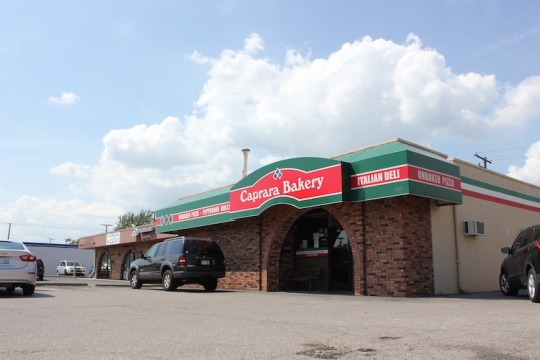
Caprara Bakery
13498 Northline Rd
Southgate, MI 48195
This place was recommended to me by Zane Hunt, one half of the Hunt brother duo that owns Via 313 in Austin, TX. They’re from this area and have some childhood favorites they hit every time they’re back in town. This was my first stop off the plane and it was a fun one. It’s a bakery, not a pizzeria. The history of pizza is rooted in bakeries and many still serve room-temperature slices to accompany your loaves and Italian groceries.
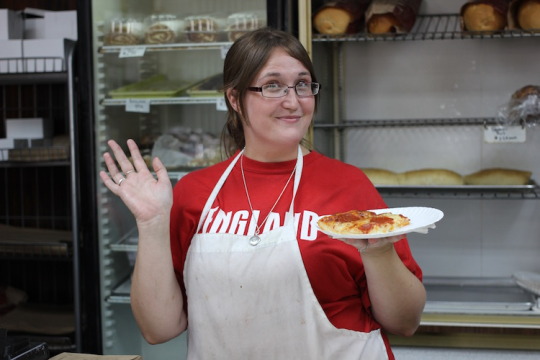
This is Crystal and she’s suuuuuuper nice. She immediately knew who I was talking about when I mentioned the Hunt brothers and let me snap this pic as a “Hello!” Very sweet start to the trip!
I poked around the shelves but didn’t see any products that were terribly exciting, but it’s good to know there’s a place to get imported tomatoes and pasta if that’s what you’re into. The main event is definitely the bakery. All the breads looked decent, just like the old school bakeries in NYC and Hoboken.
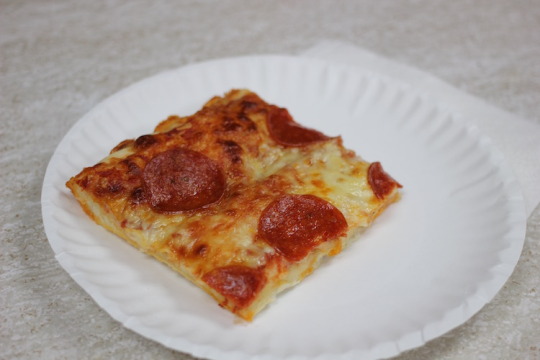
This is bakery pizza. It’s similar to grandma pizza and Sicilian pizza, but not nearly as sturdy. It’s sort of an afterthought, using leftover dough with other ingredients that are sold in the store. It’s baked in a pan and served at room temperature. The underside was extremely pale, but it wasn’t raw. I liked the tight CSR (cheese-to-sauce ratio) but didn’t love that the basic slice has pepperoni on it. I guess this is Michigan. Overall, this was a really fun stop but not essential to the Detroit pizza experience.

Frank’s Italian American Food
3144 Biddle Ave
Wyandotte, MI 48192
My next stop was another recommendation from Zane Hunt. He told me this would be the last meal on earth for him and his brother Brandon. It’s a casual Italian American restaurant (aptly named restaurant) like the ones I grew up with, but their pizza is more Midwestern. The crust is thick enough to support the ample cheese and a cooked tomato sauce. What really stuck out me here was the quality pepperoni. The staff told me this isn’t a recent switch to follow the current trend of cup-and-char pepperoni, it’s the same old stuff they’ve always used.
The pizza looks pretty standard and I was not expecting to have the same feelings toward it that the brothers Hunt foster, but I did have to hold myself back from eating a second slice. It’s funny, sometimes the pizza that isn’t technically perfect and event is exactly what you want.
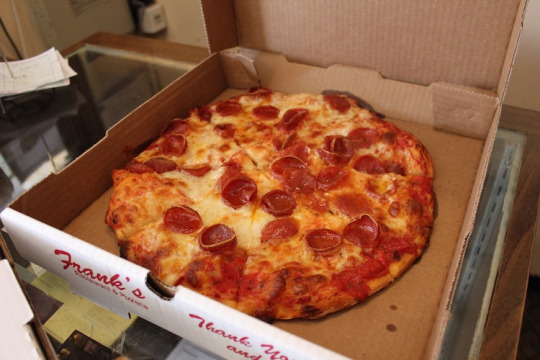
Frank’s is an old restaurant, run by the same family since 1952. The young server I spoke with seemed to know a lot about the history. It turned out her aunt is the current family member in charge of the place. The customers are also long-timers. I ran into a guy named Danny who was taking a couple small pies on his motorcycle all the way to Grand Rapids, about 2.5 hours away.
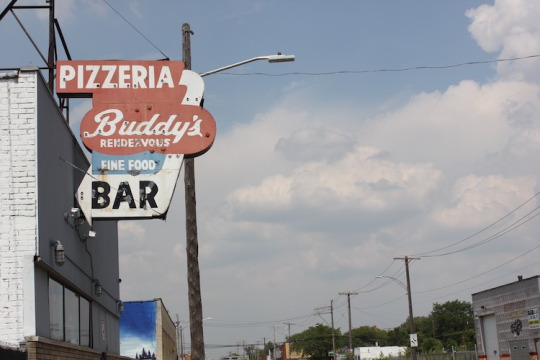
Buddy’s Rendezvous
17125 Conant St.
Detroit, MI 48212
I’m ditching the chronological reporting style for a thematic one now that we’ve taken off the edge. I always start a trip with pizzerias that are not the main attractions for the city. When I went to Phoenix, AZ a few years ago I waited until Day 2 to hit Pizzeria Bianco. Buddy’s was the first stop on my second day, but it was the most recommended pizzeria in town. This is the official birthplace of Detroit style pan pizza. The place was just a bar in 1944 but added pizza in 1946.
Using the kind of steel pans that were manufactured for the auto industry, Buddy’s started making Sicilian pizzas. Since the pans are deeper than standard Sicilian pizza pans, the dough proofs in the pan with a more angular shape. In addition, the toppings can spread all the way to the edge of the pie, leaving behind no rim to hold. Instead, the perimeter gets a deliciously charred cheese border. Sauce is usually applied above the cheese, which is why some call this style Detroit Red Top.
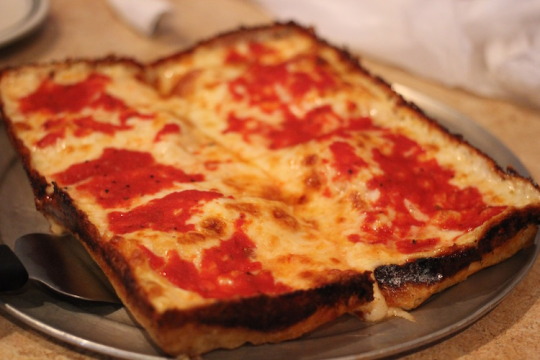
The pizza here is great. It might have even been my favorite of the entire trip. Up until now, the only Detroit style I’d had was Pi-Squared in Hendersonville, NC, Emmy Squared in Brooklyn, the related Emily in Manhattan, and a reheated Buddy’s pizza shipped to Brooklyn for a taste test (plus a few competition pizzas I judged). This has always been thought of as the benchmark and I can honestly say the description is accurate.
I visited the original location, which isn’t in the nicest neighborhood. They even have a parking lot attendant on duty all day to make sure nobody steals your car. What service! There are at least ten additional locations but I didn’t have time to check any of them out. I have a feeling this location will be on my hit list every time I go back to Detroit. Great pizza!
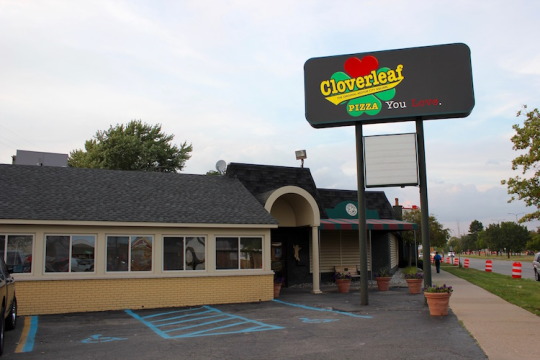
Cloverleaf
24443 Gratiot Ave
Eastpointe, MI 48021
In New York pizza terms, this is the Totonno’s to Buddys’ Lombardi’s. Does that make any sense? Gus Guerra founded Cloverleaf in 1953, but he’s the guy who brought pizza to Buddy’s in 1946. Here’s where my analogy gets a little thin. Antonio Pero was a pizza maker at Lombardi’s but the jury’s still out on whether or not he was responsible for bringing pizza there in the first place. Guerra is almost certainly the root of the Detroit pan pizza … well, actually his wife gets the real credit.
I heard the story from Jack Guerra, son of Gus. As he explained to me, Gus was born in San Marino, Italy (up in the north). Jack’s mother was born in the U.S., but her mother was from Sicily. Jack’s grandmother would make traditional Sicilian sfincione, a type of focaccia covered with crushed tomato, caramelized onion, and breadcrumbs. It was this recipe that became the Detroit pan pizza after Gus noticed that the thick rectangular pans used by the auto industry would work well for the dish. On top of the square shape of Detroit pan pizza, its other central characteristic is the use of Brick cheese, which forms a charred border around the pizza’s edge. Gus told me that Brick cheese was popular in the Hamtramck neighborhood of Detroit, a Polish enclave located near Buddy’s. It became a staple on Detroit pan pizzas because it was available nearby.

When Gus left Buddy’s in 1953, he opened a new shop in the neighborhood now called Eastpointe. Gus’s kids run their own locations and the company has even started franchising. I only went to the original location so can’t speak for the others. But this place is great, although more stylized than the other spots.
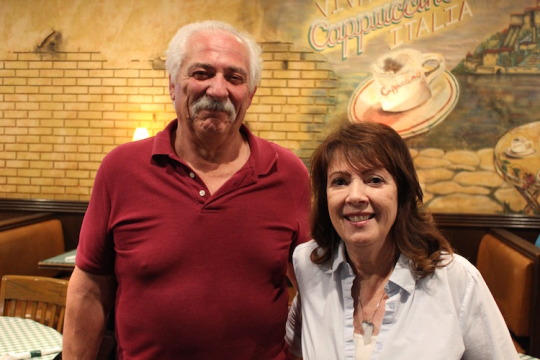
Gus’s son Jack and daughter Marie run the operation now and they were incredibly kind to spend time with me on my visit and answer questions they’ve probably gotten a thousand times before. No book or article can possibly replace the experience of hearing these stories in person.
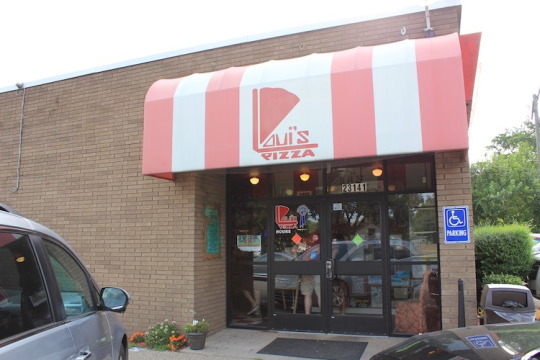
Loui’s Pizza
23141 Dequindre Rd
Hazel Park, MI 48030
Speaking of stories, here’s yet another link in the chain of Detroit style pan pizza. Loui Tourtois opened the place in 1977 after making pizza at Buddy’s for years. He was taught by Gus Guerra, so absolutely part of the original lineage. His pizzeria is the most iconic and cozy feeling in town, with chianti bottles covering the walls and ceilings. Seriously, there are thousands of these things everywhere. But the decor isn’t nearly as interesting as the pizza.
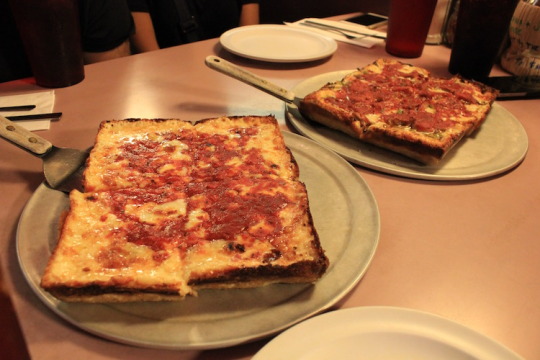
This was my first taste of actual Detroit pan pizza. Like Buddy’s and Cloverleaf, it’s rectangular and has a border of burnt cheese. The biggest difference is that this beast is more dense than its compatriots. It felt heavier in both the hand and the stomach. I didn’t dislike this, but after tasting the others I can easily say it wasn’t my favorite. The one way Loui’s DOES win is in ambiance. It’s an old school dark room with wood paneling and stained glass – all the things I look for in a classic midwestern pizza joint. It had a vibe like Marie’s in Chicago, only much messier. Loui’s has empty chianti bottles hanging all over the place. It feels really special in there.
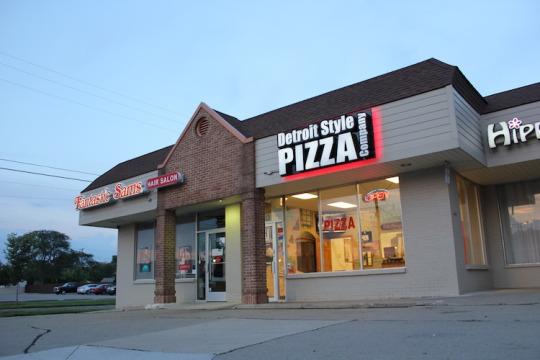
Detroit Style Pizza Company
28630 Harper Ave.
Saint Clair Shores, MI 48081
Shawn Randazzo is a world champion pizza maker whose pizza I have had the pleasure of judging several times over the past decade. His specialty is the Detroit style pan pizza and that makes perfect sense knowing that he ran a Cloverleaf location for over 15 years. After leaving Cloverleaf, he opened a couple pizzerias and focused on exporting this style of pizza to the rest of the world. Now he consults for pizzerias and even sells the equipment and ingredients required to make it.
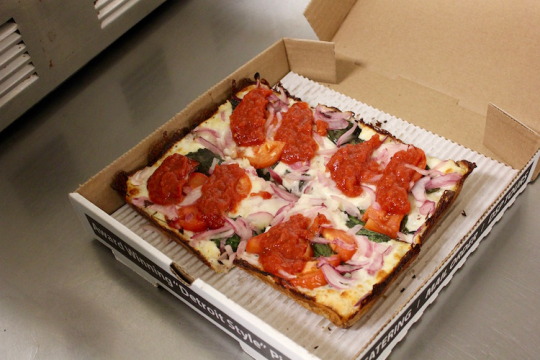
One of the locations has transformed into a shipping center but the spot I hit is still a living, breathing pizzeria. It’s more of a take-out spot than it is a dine-in restaurant, so our pie hit the table in a box. We didn’t let it sit before popping the top and digging in. I have to tell you this pie had the most perfectly charred cheese along the perimeter. Really special. What’s really cool here is that they apply the sauce AFTER the bake. WHOA! I didn’t see that at the other spots, but suppose it’s possible since I didn’t have my head in the kitchen like I did at DSP.

Mani Osteria
341 E Liberty St
Ann Arbor, MI 48104
This wasn’t a long trip, but I saved some time for a quick jump over to Ann Arbor to see some friends and OF COURSE they wanted to meet up for pizza. That’s cool, because several people had recommended this place to me. Mani is a typical classed-up pizza joint serving neo-Neapolitan pizza from a wood-burning oven. That means that the crust is more sturdy than a typical Neapolitan pizza even though it has a lot of the same visual features. The bake is a bit longer and the flour used for the dough is often stronger than the typical low protein variety.
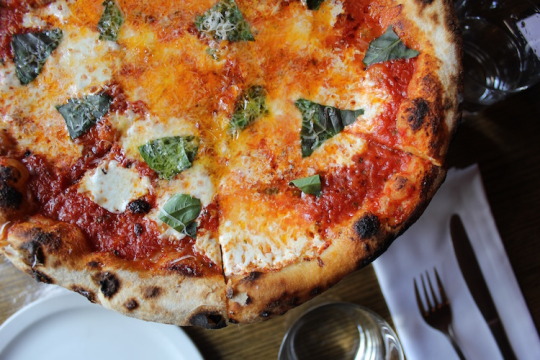
The midwest usually treats pizza like a junk food but this kind of place is more of a dining experience. They use cloth napkins and have a fancy looking wood fired oven. The pizza has blisters the way more standard Neapolitan pizzas do. I get why so many people told me to check this place out, but can’t say the pizza was exceptional in the universe of pizza.
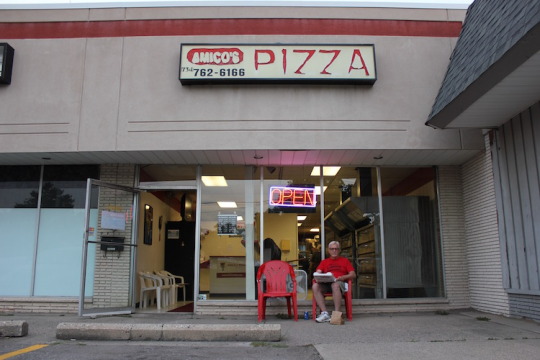
Amico’s Pizza
28422 Joy Rd
Livonia, MI 48150
This place is special. It was recommended to me by my friend / pizza tour guide Joe Garreffa. Joe worked here when he was in high school so it holds a special place in his heart. It’s a family owned business that has been around for decades, although it moved into this strip mall a few years ago. They make both round and square pies, with their square looking more like a Sicilian than it does a standard Detroit style pan pizza.
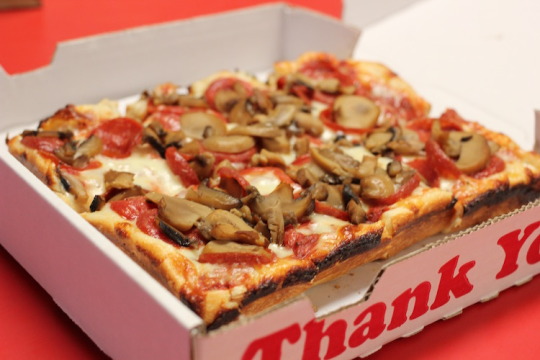
I had a similar feeling about this pizza that I had about the places recommended to me by the Hunt brothers. This is a total neighborhood joint. Joe’s connection to the family and their pizza keep him coming back and I think that is absolutely beautiful. Even he flinched a bit when I showed him this picture of a pie topped with canned mushrooms, but that doesn’t take away from the feeling he gets when he stops by for a pie. Sam Sifton wrote about the pizza cognition theory in Ed Levine’s book Pizza: A Slice of Heaven and I believe Amico’s to be the perfect example. The pizza you grow up eating defines the very word itself. The owners of Amico’s might not realize the incredible power they have that came from sticking around.
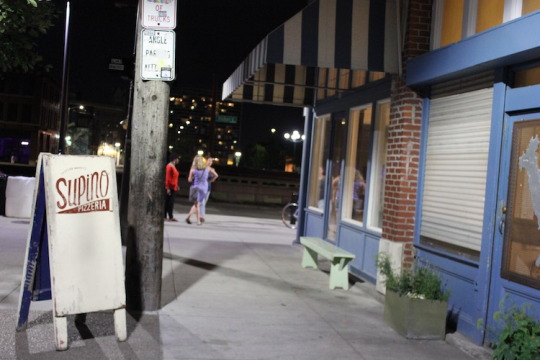
Supino
2457 Russell St
Detroit, MI 48207
The goal of my trip to Detroit was pretty clear: to understand Detroit’s indigenous pizza style. That means I ate a ton of thick, rectangular pizza with charred cheese edges topped with cooked red sauce. I would have been perfectly happy sticking to pizzerias that fit this description, especially because I ate quite a bit of it in the 2.5 days I spent in town. But people kept offering suggestions and I found it hard to ignore all the voices imploring me to give Supino a try. So at the end of a very long day of pizza eating, which included the drive to and from Ann Arbor (plus some more pizzerias I’ll post about later), I decided to end the night with one final stop.

Supino is another neo-Neapolitan pizzeria, slightly less upscale than Mani in Ann Arbor but more elevated in its pizza. The crust is thinner at the edge but lightly charred like all good high-temp pies should be. The ingredients on top were well proportioned and every slice had a nice balance of flavor and consistency. I don’t think I liked this as much as everybody who told me to check it out, but that might have something to do with the fact that I had crammed about a dozen pizzerias into a seriously short trip and this was the final major stop. Even so, I found the pizza to be a worthy alternative to the thick pan pies I got to know over the two days prior.
Detroit clearly has a serous pizza scene happening right now, but I think it’s safe to say the real action is with the old school variation introduced by Gus Guerra in the 1940s. THANK YOU GUS!

